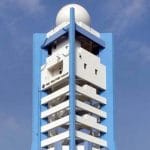A recently published study has revealed unprecedented growth of exotic species — one of them an invasive shrub that has invaded more than five million hectares in the country — across Karachi, causing destruction of indigenous flora.
It also shows that there is no significant relationship between heatwaves and exotic species, especially the Conocarpus erectus, a mangrove shrub widely planted in the city over a decade ago.
The study — Mapping spatial distribution of invasive alien species through satellite remote sensing in Karachi, Pakistan: an urban ecological perspective — has been published in the International Journal of Environmental Science and Technology.
The study focusing on two exotic species is conducted as a joint venture by Karachi University’s department of geography in collaboration with the Humboldt University in Berlin, Germany.
No link found between heatwaves and exotic species
It found the invasive shrub — Prosopis juliflora (a kind of mesquite) locally called velayati keekar or devi — in almost every habitat of the city, including mountains, wetlands, urban and rural areas.
/prosopis_juliflora1_-_FKS.jpg)
Whereas the Conocarpus (buttonwood) — native to Central and South America — dominated urban areas especially along roadsides, greenbelts, ‘acutely dismantling indigenous plant species’.

It was also observed extensively along riverbanks and coastal areas affecting the local biodiversity.
“It has been revealed that the selection of alien species for the fragile urban environment is a serious threat for the indigenous flora and fauna of the local environment,” the study says.
‘Culturally invasive’
According to the study, the city of Karachi is dominated by mountains on its west, north and east sides. About 51 per cent of the city’s total area is surrounded by undulating mountains.
It has a total vegetation cover of 7.314pc distributed into three zones: open areas, built-up areas and mangroves. The vegetation in open areas comprises 48pc of the total natural vegetation, followed by the vegetation in built-up land, which comprises 39pc. The mangroves cover only 13pc of the total vegetation under the administrative boundary of the city.
“The unintentional introduction of alien species in Pakistan has also led to the upsurge of invasive species to the extent that they outnumber local indigenous species.
“This is particularly the case with Prosopis juliflora, which was introduced by the British government in the 1860s and has since devastated the ecological habitats of the Sindh province,” it says.
According to the study, it is the most destructive plant species found in almost every habitat from southern to northern Pakistan, but it is highly dominant in southern Sindh.
“This invasive species has altered the local habitats of plants and birds,” said Prof Jamil Hasan Kazmi, the lead researcher of the study, citing the IUCN Red List, which described mesquite as one of the top 100 alien invasive species in the world.
Referring to a study conducted in 2010, he said this species was spreading at a rate of 25 square kilometre per annum and had invaded more than five million hectares (about 2pc of the total area of Pakistan) when the present study was carried out.
About Conocarpus, he said it was introduced in 2005-06 in Karachi when around 2.2 million plants of this species were officially imported at a very high cost.
“I have described Conocarpus as culturally invasive in my paper as its plantation on a large-scale has threatened local flora, countless of them removed under government initiatives for its plantation. Resultantly, many parts of the city are now seriously deprived of local flora. Human interventions and low priority of conservation have affected plant diversity in the city.
“Furthermore, the indigenous agricultural areas of Karachi, which used to provide grains, fruits and vegetables to this megacity, have also been seriously affected in this process.”
Explaining how researchers studied vegetation cover with respect to change in temperature, Prof Kazmi said areas were selected with high and low presence of exotic species and their changes in temperature were monitored over the last 20 years on the satellite images.
“The areas with Conocarpus erectus were not showing any significant temperature change. The overall temperature increase is mainly due to the excessive use of concrete/asphalt and presence of high traffic volumes in sample areas.”
Asked about the areas most affected by the two exotic species, he said mesquite was largely found in the city’s open and non-irrigated areas on the rural fringe while Conocarpus was dominant along major roads/highways, riverbanks and cantonments.
Sharing suggestions on how to bring about environmental improvement, he said: “Karachi needs an integrated plan on a war-footing for tree plantation and conservation, which should consider the city as a single geographical entity. Right now, the city is divided amongst 37 agencies lacking coordination.
“Secondly, the government must ban introduction of exotic species on a mass scale. Their plantation should only be done with the approval of an integrated environmental body representing stakeholders and experts,” he suggested.
Earlier, a KU study published in 2019 showed that Karachi exhibited extremely low flora diversity with exotic species outnumbering native ones. It found that several major streets did not have any trees at all while countless trees had been uprooted over the years to create space for ‘development’ projects.
![]()





